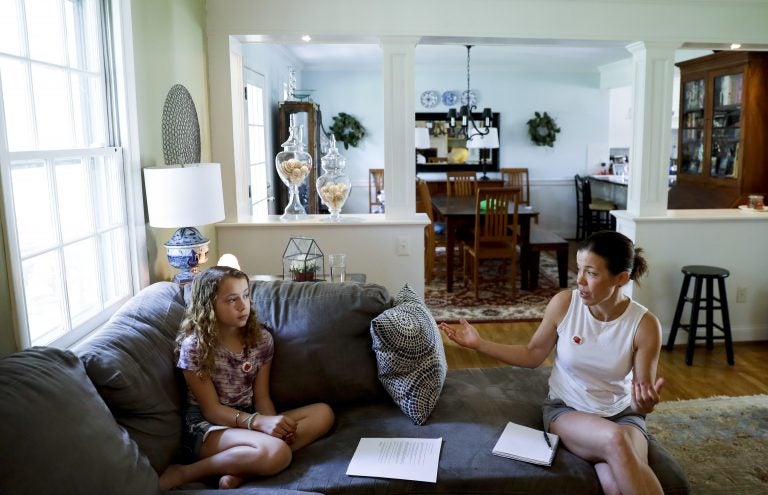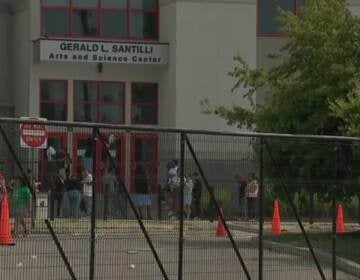Pa. threat case throws spotlight on hard choices for schools
When deciding whether to expel a student, administrators must balance the safety of an alleged victim with the accused's right to an education.

In this Thursday, May 3, 2018 photo, Sandy Nissenbaum, (right), and her daughter, Nora Nissenbaum, 12, talk during an interview with The Associated Press in Wayne, Pa. The case of a suburban Philadelphia boy who was quietly allowed to return to class after being accused of making a shooting threat has thrown a spotlight on the hard decisions school authorities must make. Nora Nissenbaum who says the boy bullied her has withdrawn from class for fear of him. (Matt Slocum/AP Photo)
When 12-year-old Nora Nissenbaum told a boy from her class she wasn’t interested in him anymore, he started texting her images of Adolf Hitler and insults such as “dirty Jew.”
Nora’s parents contacted her suburban Philadelphia middle school and police. Soon after, word spread that the boy had supposedly threatened to take a gun to class and target 33 people, including Nora.
But within a week, the boy was back in class despite facing criminal charges in juvenile court, and he and Nora were crossing paths in the hallway eight times a day.
“Knowing that he wants to hurt me scares me a lot,” said Nora, who has elected to finish the school year at home with the case against her classmate still unresolved.
Across the country, school officials dealing with threats of violence in this era of mass shootings are facing similar choices and constraints.
When deciding whether to expel a student or let the youngster return, administrators must balance the safety of an alleged victim and other schoolmates with the accused’s right to an education.
“Schools are up against this problem all the time,” said Amy Klinger, director of programs at the advocacy group Educator’s School Safety Network. She said no fixed policy exists on how to deal with these situations; instead, they tend to be handled on a case-by-case basis.
Klinger’s research indicates that 75 to 90 threats per day were recorded in the U.S. during the month after the deadly Feb. 14 shooting rampage at a Parkland, Florida, high school. Since April, that has dropped to around 20 a day, she said, but that’s just the ones that became public.
In some cases, experts say, youngsters who make homicidal threats are moved to institutions that focus on children with emotional disturbances.
Pedro Noguera, an education professor at the University of California at Los Angeles, said administrators need to take into account such factors as how serious the threat is and whether the child has access to weapons.
In the Philadelphia-area case, the boy “should not be at the school with that girl while he’s awaiting trial,” Noguera said. “No way. No way.”
Klinger said that probably a majority of students who make shooting threats return to their schools because their words aren’t deemed credible.
Most of them never carry out their plans, but some do. At a high school outside Denver in 2013, Karl Pierson shot and killed a classmate months after threatening a librarian and debate coach.
Because of privacy policies protecting juveniles, administrators at Tredyffrin-Easttown Middle School would not confirm information provided by Nora, her parents and their attorney. School officials made no public announcement about the case, and other parents know only what they heard around town.
“When necessary, we’ll work with law enforcement and as it’s deemed needed, there’s communication with those that need to be made aware of those things,” said Mark Cataldi, director of assessment and accountability for the well-to-do and highly regarded district.
Chester County District Attorney Thomas P. Hogan said he could not comment on pending cases but added he had no reason to think the girl’s parents would give an inaccurate account. An attorney for the boy did not respond to requests for comment.
From flirting to death threats
At cotillion, Nora and her classmate decided they liked each other. She thought he was cute. But when she heard he bullied her friends at a dance in February, it bothered her. A few days later, she wrote him to say she was no longer interested.
Then came the texts. “What’s better baked? 6 million Jews,” read one of the memes shared with The Associated Press. In another text, he told her to “go back to ur concentration camp.”
Nora’s mother, Sandy Nissenbaum, found out about the bullying in March. After an investigation by the school, Nora’s parents were told action had been taken but were not given specifics. The boy was not in school for five days, and they assume he was suspended.
While he was absent, some of his classmates became concerned. They had heard him say that if he were suspended, he would go to the school with a gun and go after Nora and others, according to Nora’s family.
Nora’s mother and father learned of the alleged threat from another parent, and Sandy Nissenbaum called the principal. “I didn’t know what was what. Is it real?” she said. “So you go and you act like it’s happening now.”
Nora was pulled from class and held at a police station for hours as the boy was questioned. Local police would not elaborate on what followed, citing state privacy law on juveniles.
A father with a daughter in Nora’s grade, Drew Holzapfel, heard about the alleged threat from other parents. He met with Principal Andy Phillips, who assured him the students were safe.
Holzapfel noted the district communicates readily on other matters, whether lice outbreaks or changes in school traffic patterns.
“It seems to me that an issue such as this would warrant even greater communication,” he said.
School reaction
The boy was charged with harassment and making threats, according to Nora’s family. But his parents and the school administration had him examined psychologically and decided he could return to school, said the Nissenbaums’ attorney, Joel Frank.
When he came back, he and Nora were told by school officials not to talk to or about one another. His locker was moved farther from hers, and his schedule was changed so he no longer had classes with her.
Nora’s parents asked for other changes so the youngsters would not see each other so often, but the administration refused.
Once, when they crossed paths, they were the only two people in the area, Nora said. She watched nervously in her locker mirror.
“It was scary because there was no one around and I felt like he could pounce at any moment,” she said.
A court granted Nora an order of protection against the boy, but she still feared for her safety. She has been diagnosed with post-traumatic stress disorder, according to her family, and has been put on medication but still has panic attacks.
Nora wonders how an adult would feel in her position. “Nobody would want to go to work with someone who threatened to kill you,” she said.
WHYY is your source for fact-based, in-depth journalism and information. As a nonprofit organization, we rely on financial support from readers like you. Please give today.




